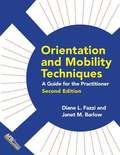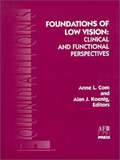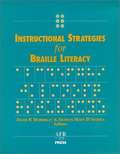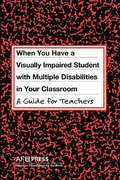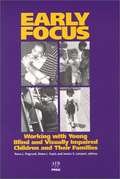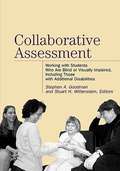Special Collections
American Foundation for the Blind
Description: American Foundation for the BlindPress offers a wide range of information for students, professionals, researchers, and blind and visually impaired people and their families. #teachers #disability
- Table View
- List View
Diabetes, Vision Impairment, and Blindness
by Allene R. Van SonVision impairment is a common complication of diabetes mellitus, which is itself the leading cause of new cases of blindness among adults in the United States. Three percent of the country's 10 million diabetics have experienced severe vision loss as a result of the disease. This means that diabetics frequently have to face additional problems of impending loss of vision and blindness. The purpose of this pamphlet is to explain the relationship between visual impairment and diabetes and to identify recent advances in treatment and rehabilitation to help diabetics and their families deal with the problems of vision loss.
Sex Education for the Visually Handicapped
by American Foundation for the BlindSexuality is at present very much in the spotlight. It is stressed over and again by educators and child psychiatrists how important a good sex education is for the optimum development of the child.
Visual Impairment
by Ian L. Bailey and Amanda HallA general, down-to-earth look at the common forms of vision loss and their impact on the individual. Explains the different aspects of visual impairment, describes adaptive techniques and devices, and provides information on available resources and services in a concise and easy-to-understand manner for busy professionals and visually impaired people and their families. Visual Impairment: An Overview seeks to clarify misconceptions and misunderstandings of the different aspects of visual impairment, describe adaptive techniques and devices, and provide information on available resources and services. Anyone with questions about vision loss will find this book a useful resource designed to increase understanding of visual impairment and the ability of visually impaired people to lead unimpaired lives.
Orientation and Mobility Techniques
by Diane L. Fazzi and Janet M. BarlowThe very first techniques book in orientation and mobility has been completely revised and updated for today's fast-changing world, while remaining true to Hill and Ponder's simple organizational principles that generations have known and loved. A new, easy-to-read color format, accompanying photographs, updated information on street crossings at complex intersections, and a new chapter on O&M for people with low vision make this revised edition a must-have in your O&M library.
Adjustment to Visual Disability in Adolescence
by Emory L. Cowen and Rita P. Underberg and Ronald T. Verrillo and Frank G. BenhamThis volume describes a three-year research program in which the determination of some factors relating to adjustment in visually disabled adolescents was a prime objective.
Low Vision
by Virginia E. Bishop and Jane N. Erin and Anne CornThis research report, based on a multiphase survey of professionals, identifies important trends into the next century. Designed for administrators, policy planners and university instructors, as well as for direct service providers, Low Vision includes background overview papers by six eminent leaders in the low vision field.
The Future of Work for Disabled People
by Ian Morris and Wassily Leontief and Walter Y. Oi and William F. Gallagher and Curt Tausky and Timm Kainen and Lawrence A. Scadden and William J. Dennis and Dennis Chamot and Jesse M. Smith and Erich Bloch and Joseph F. CoatesThis important book, by an impressive and talented team of authors, will help us plan to ensure that workers with disabilities find their rightful place in the workplace of the future.
Retrolental Fibroplasia and Autistic Symptomatology
by Joan B. ChaseIn this monograph, based on a study of 263 subjects with RLF (Retrolental Fibroplasia-- an eye condition caused by excessive incubator oxygen), the author examines selected variables which may significantly affect subsequent development.
A Psychiatrist Works with Blindness
by Louis S. CholdenEach patient will react to blindness in a manner characteristic for his personality. He will react to it as an emergency situation which will have most serious consequences for his future life plans. Besides the emergency aspect of the loss of vision, blindness in itself holds a number of special and deep meanings to the patient which must be considered in attempting to understand its effects. These meanings may be discussed from the psychologic, social and vocational points of view. But, because the patient will react to the problem of blindness in a way which is peculiar to him, one might predict within certain limits what the patient's reactions will be, providing we understand his personality structure.
Foundations of Low Vision
by Alan J. Koenig and Anne L. CornThis text explains in great detail how to do low vision exams, the principles behind magnifiers and other forms of magnification, and much more.
The Blind in School and Society
by Thomas D. CutsforthThe purpose of this book is to help acquaint the seeing with the blind and the blind with themselves.
Instructional Strategies for Braille Literacy
by Diane P. Wormsley and Frances M. D'AndreaOffers instructors specific, practical strategies for the teaching of Braille reading and writing. Chapters discuss general guidelines and strategies; fostering emergent learning; making the transition from print to Brail teaching Braille to students with special needs, and to students who speak English as a second langua assessing the literary skills of students who are blind or visually impaired; and technology and Braille. Annotation copyrighted by Book News, Inc. , Portland, OR
Manual for the Stanford Multi Modality Imagery Test
by William L. DautermanThe author's data on the test called "The Stanford Multi-Modality Imagery Test for the Blind" as a part of a research project has been revised in this manual under the name of "The Stanford Multi-Modality Imagery Test."
Report on Needs Assessment Methodology
by Anne Marie Delaney and Ronald L. NuttallThe major purpose of this report is to assist others who plan to conduct their own needs assessment for a blind population or for another special needs population.
Building Blocks
by Betty Dominguez and Joe DominguezThis bilingual (English/Spanish) book comprises six chapters each of Part I & II on Early Learning and Blind and Visually Impaired Children and on Activities for Blind and Visually Impaired Preschoolers.
Non-Sighted and Sighted Adults' Volumetric Perceptions of Functional Objects
by T. M. Nelson and C. J. Ladan and J. EppsA report on the study of the manner in which sighted, sighted-but-blindfolded, late-blind (subsequent to 7 years of age), and congenitally blind (blind since birth) persons employ physical parameters in determining weight and volume of functional objects.
Images of Blind and Visually Impaired People in the Movies, 1913-1985
by Wendy Erickson and Diane WolfeListed in this book are the titles and other information about movies that include characters who are blind or visually impaired.
When You Have a Student with Visual and Multiple Disabilities in Your Classroom
by Jane N. Erin and Susan J. SpunginAs a special educator, a classroom teacher, or an educational team member, you may be working with a visually impaired student for the first time or as an experienced professional. This booklet provides information on how visual impairment affects learning in communication, movement, self-care skills, and other important areas, and on how to work effectively with students who have visual and other disabilities.
Early Focus
by Jessica S. Lambert and Diane L. Fazzi and Rona L. PogrundStressing the importance of early intervention in working with children with visual impairment, Pogrund (formerly special education, California State U.) and Fazzi (special education, California State U.) offer practitioners (teachers and other specialized professionals) an edited guide to working with children under age five. Eleven chapters review the developmental areas that are likely to be affected by vision loss and discuss the theory and knowledge base behind suggested educational practices in these areas. Chapters cover working with families, medical and functional implications, cognitive development, literacy, social development, promotion of independence and daily living skills, behavioral supports, motor and mobility development, and working with other professionals. Annotation (c)2003 Book News, Inc., Portland, OR (booknews.com)
English / Spanish Basics for Orientation and Mobility Instructors
by Christian J. FoyThis book was written as a teaching aid for orientation and mobility (O&M) instructors. Author's intention is not to teach the techniques of the profession but to supply the vocabulary instructors might use to teach students in Spanish.
From Homer to Helen Keller
by Richard Slayton FrenchFrom Homer to Helen Keller, Homer stands for the greatest achievement of the blind in the times antecedent to their systematic education. He stands for all those bards, many of them blind or blinded, creators of literature and makers of our language, who through ballads, always of great vigor and sometimes of surpassing beauty, have handed down to us the glorious traditions of far-off heroic times.
Miss Keller stands for the supreme achievement of education. The blind claim her, but the deaf can claim her, too, and modern education can claim her more than either--and all humanity claims her with the best claim of all. For she is the epitome of all that is best in humanity, all that is most spiritual; and all this through conscious aim and directed effort, through education in its best sense.
What Museum Guides Need to Know
by Gerda Groff and Laura GardnerThis book provides practical, easy-to-use suggestions on how to greet and assist blind and visually impaired visitors. It also covers aesthetics and visual impairment, legal requirements for accessibility, and resources. It includes a training outline for museum professionals, a bibliography on art and museum access for blind and visually impaired persons, and guidelines for preparing large print, braille, and cassette materials.
The Demography and Causes of Blindness
by Hyman GoldsteinA report on the statistics of blindness from an international point of view.
The Demography of Blindness Throughout the World
by Hyman GoldsteinMost of the world's blindness could be prevented, and the attack on it and its consequences proceeds apace through such organizations as the World Council for the Welfare of the Blind, the International Agency for the Prevention of Blindness, and the World Health Organization.
For greatest effectiveness, their programs must be based upon accurate data, as a WHO study quoted here by Dr. Goldstein makes clear: "In order to establish appropriate priorities for prevention and treatment at the national and international level, it is essential that reliable up-to-date statistical data on prevalence, age of onset, and causes of blindness be obtained."
But even in the United States, where collection of data on blindness began in 1830, there are still no reliable trend data. In much of the rest of the world data are fragmentary, and data that would allow valid country by country comparisons are almost non-existent.
Dr. Goldstein has done a valuable service in pulling together such statistics as can be found, and in discussing their weaknesses and strengths.
Collaborative Assessment
by Stephen A. Goodman and Stuart H. WittensteinThis comprehensive text published by AFB in 2003 is the first to present assessment in a way that can be understood by professionals and families alike.

